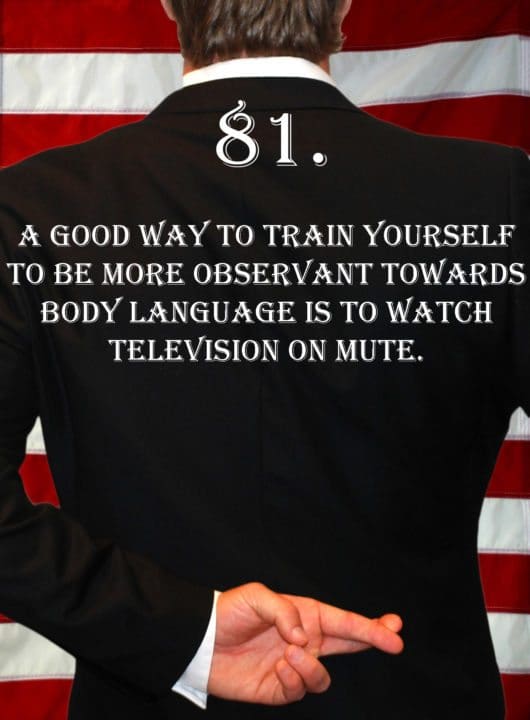
Deception Tip 63:
Liars may sometimes breathe in through the nose and out through extended lips like those of a chimpanzee.
Listen To The Podcast!
E63 – Chimpanzee Lips – Deception Tips Podcast – Click Here To Subscribe
Podcast Transcript
Hello and welcome to the Deception Tips podcasts where you will learn amazing cues to detect deceit that will help you read people like never before. I’m your host Spencer Coffman, let’s get started.
Welcome to Deception Tip episode number 63. Last time, we spoke about how liars will say their statements twice, with their voice rising the second time around. This is different from people who are giving lectures or talks or sermons or whatever when they are speaking, and they repeat their last sentence for emphasis or their last phrase for emphasis.
Their voice usually goes down and they usually speak a little bit slower, when they repeat their sentence. However, when people lie, remember they’re under a lot of stress and they’re under a lot of tension and this stress and tension does a lot of things to the body that is quote-unquote not normal. So, that means that your body will be different when it is stressed and tense than when it is not stressed and intense.
So, when your body is stressed, we have examined a number of different things that happen. You know the fight or flight mode, the saliva production, digestion, where your blood flow goes, where your energy goes, that sort of thing. So, when someone is stressed and tense, their vocal cords and their diaphragm and everything may be contracted, it’ll be tightened up.
Therefore, their voice may rise because their vocal cords aren’t as loose. Remember the rubber band analogy where if you have a rubber band and you strum it or pluck it, it’s a low sound, but as you get it tighter and tighter and tighter, it becomes higher and higher and higher. Just like your vocal cords, when they get tighter, your voice gets higher.
So, when people lie and they’ll say their statements twice, the first statement they’re saying normally, the second one they’re saying again, but they’re getting more stressed because they realize they’re repeating it. This is giving you another opportunity to spot the lie in their statement, so all of a sudden, they get really stressed and tense.
Boom, their voice goes up the second time around, and now unconscious, nonverbal, well, it is verbal, an unconscious sign of deception has been leaked for your unconscious to pick up.
However, you are listening to the Deception Tips podcast and you are hopefully watching the videos, reading the book, so you now know that these signs are a part of your conscious rather than your unconscious. Therefore, when it happens, you’re able to see it and spot the lie and understand that person is being deceptive.
Today, we are going to talk about another sign of deception on the face, the last one was on the face because it was a voice, I suppose you could call it the head and neck, this one is going to be on the lips.
We’ve talked about the lips several times over the course of the Deception Tips podcast. We hit it up in number 32 where we talked about how liars will frequently lick their lips, this is due to their dry mouth.
Remember, stress, tension reduces the production of saliva, the mouth becomes dry, and they will lick their lips frequently to keep them moist. Then episode 34 we spoke about liars’ lips in general, that they will take on all sorts of different positions.
They may bite them, suck them inward, bite the lip corners, stuff like that where they’ll twist them around and play with them a little bit because they are unconsciously trying to bite back whatever they’re saying.
The lips are what allow us to speak, we get the message out with our lips by biting them, contorting them, and everything, they’re twisting their message around. Then we skipped up to episode number 45 where we talked about Hushing Lips. This is an interesting situation where the liars will put a finger or maybe their hands or something over their lips or over their mouth to silence themselves.
You’ll typically see it with the typical shushing behavior, one finger up or it may be their whole hand or both hands, you get the idea, they’re telling themselves to be quiet.
Then the next episode, number 46, we talked about ‘Pursed Lips’, where liars can purse their lips when they are being deceptive. This is like puffing up their cheeks and then slowly exhaling through the pursed lips to pacify the tension.
This is like a blowfish or a pufferfish, they’re puffing them up then they’re exhaling slowly through the pursed lips, which are closed. This is to release the stress, release the tension that’s happening. Then today, in episode number 63, we’ve got something called ‘Chimpanzee Lips’.
So, here it is, deception tip number 63. Liars may sometimes breathe in through the nose and out through extended lips like those of a chimpanzee. Here it is again, deception tip number 63. Liars may sometimes breathe in through the nose and out through extended lips like those of a chimpanzee. So, what does this look like? Well, it can take on a variety of forms and it could also incorporate some of those other lip behaviors we’ve talked about.
One thing I do want to mention is if you don’t remember all of those episodes then I encourage you to go back and listen to them again. You can listen to them at double speed if 15 minutes is too long for you, that means you have half the time.
If you still don’t have the seven minutes that it’s going to take you to listen to it then go on YouTube and watch the videos on the deception tips blog on spencercoffman.com.
Check those out, you need to refresh your memory on all of these lip behaviors we’ve spoken on because then you will really begin to understand how they all play together.
For example, they may sometimes breathe in through the nose and out through extended lips. Well, when they’re breathing out through extended lips like a chimpanzee, they may also puff up their cheeks a little bit first then purse, then extend the lips.
So, it’s like an all-in-one factor that could happen, so if you know, hey, wait a minute, that’s a cluster. I saw the pursed lips, I saw the chimpanzee lips, and I saw the pufferfish cheeks, three different things right there. They are doing a cluster with breathing, chances are you are going to see a bunch of other behaviors with that, so pay attention to it and look for other behaviors as well.
Chimpanzee Lips, you guys know how monkeys have their lips, they push them out, they’re big, you see it all the time on TV, they may be flip them inside out, that kind of thing.
This isn’t that extreme, but it is similar, they’re pushing their lips outward like a duckbill or something like that, except it’s not those selfie pictures where people are trying to look all hot and sexy type of a thing. It’s more of stress release, tension release, etc. and we’re going to talk a lot more about it coming up right after this.
How about having a handy guide filled with quick tips to detect deception? Now you can. ‘Deception Tips’ is an eBook with 101 cues to detecting deception. Grab your copy today at spencercoffman.com or any major retailer.
Welcome back to deception tip episode number 63 where we are talking about Chimpanzee Lips. We’re talking about the lips in general, we’ve gone over several past episodes that I hope you remember. If not, I encourage you to go back and review them because they’re all about the lips and the different things the lips will do when someone is lying.
Remember that old joke, how do you know when a politician is lying? How do you know when a woman is lying? How do you when whatever is lying? You can put in your own term. Their lips are moving, that is how. The lips are a very tell-tale sign of liars, there are a lot of different things, we’ve covered a lot of them.
Today, we are talking about Chimpanzee Lips. So, liars will do this because they want something to do with their lips. They’re looking for another behavior to put on the lips to get their mind off of telling a lie. It’s almost like a replacement gesture, or a pacification gesture, they’re pacifying themselves about the lie. They’re telling themselves, it’s okay, it’s a comfort gesture.
Remember we’ve talked about these comfort gestures like folding the arms where you’re giving yourself a little bit of a hug. Pacification is like doing something else instead of what you want to do.
So, those things are happening with this, with the lips, with the chimpanzee lips because they’re pushing those lips out, they’re doing something else to get their mind off of telling the lie.
In addition, they’re releasing the stress and tension involved in telling a lie. So, typically, when would you see this? Well, you could see it at any time. Usually, though, you’re going to see it at the end of someone’s paragraph or sentence or whatever.
When they’re done making their point or making their case, you’re going to see this behavior. Why? Because it’s a sign of relief, they have finally gotten their lie out, they feel like they have sold it to you, whatever the case may be.
It’s like a sigh, it’s like a deep breath, they’re going to breathe in through their nose, out through their mouth like a yoga meditation type thing and say, ah. But instead of doing that, they’re breathing out through these chimpanzee lips because the unconscious is sneaky. It wants the truth to be found, it wants the truth to be seen, heard, and understood.
That means that when this relief of ah goes through the conscious and it does all these behaviors, the unconscious is going to say, wait a minute, I want the truth to be heard, so it’s going to have them do this chimpanzee lips and push their lips out a little bit more.
It may have them do the pufferfish cheeks or pursed lips or something like that in addition to all of this so that there can be a nonverbal sign of deception leakage that will happen in addition to the conscious feeling of ah or winning or satisfaction.
They will both be satisfied, and it is up to the other person, the target, to determine whether or not those behaviors are normal or whether or not they are unconscious signs of deception.
Hopefully, since you understand how to read people and detect deception, you will be able to pick up on that because you have made these signs a part of your conscious behavior.
You will now understand how to read people, how to detect deception, how to see them, and how to know and interpret these signs. In reality, hopefully, all of these podcasts are review for you because by now I have the Deception Tips Blog that has been up for a couple of years. The Deception Tip eBook has been out for over a year and the Deception Tips Revised and Expanded has been out for several months now.
Hopefully, you’ve read all of these and you understand them, so all of these podcasts are just a little bit more of an in-depth look at these signs of deception. It’s more review for you, more confirmation.
They say that you need to hear and understand something seven times before you fully comprehend it. Well, we’re on a good path, we’ve got the Deception Tips Blog, that’s one. We’ve got the Deception Tips eBook, that’s two.
We’ve got the Deception Tips Revised and Expanded edition, three. We’ve got the Deception Tips videos, that’s four. We’ve got the Deception Tips Podcast, that’s five. We also have the Deception Tips website, which would be six. So, now you have six different media outlooks that you can see and read and understand before you fully comprehend it, you need one more, that’s all.
What you could do is go through and read the transcripts, which are all on the Deception Tips website and that could be another, that could be seven. As long as you don’t do them all in one day, you can break them up, do it one day a week, or whatever the case may be. You now have seven different avenues so you can fully understand these signs of body language and deception.
In addition, you’re hopefully practicing them in the mirror or doing them on yourself or recognizing them on yourself and seeing them and other people. That is additional exposure.
So, just with these outlets alone, you’ve got six or seven different ways to get introduced and familiar with this information. Then in the real world where you’re incorporating it and paying attention to it on yourself, you may have a few more ways.
So, there’s no excuse, you will be able to learn to detect deception, it is a teachable skill, this is something that you can definitely do. It may not seem like you are able to, you may not feel like you’re able to, but you are.
You are good at reading people because when you become good at reading people, you don’t necessarily know it. All of a sudden, you’re just going to know, you’re going to feel like something’s off.
You’re going to know something’s off, you may not be able to pinpoint each exact little behavior and explain it to the person who’s lying as they do on TV if you’ve ever seen that show ‘Lie to me’ or ‘The Mentalist’ or anything like that, that’s advanced.
It’s so advanced that there aren’t even a lot of people that can do that, they aren’t that knowledgeable, it’s just an anomaly that someone is actually like that.
They do that for the TV and for education and things like that. It’s just more for the show. Can people really be that good at reading people? Yeah. There are people on stage that call themselves Mentalists or whatever, they specialize in psychology and reading body language. You could do that if you want, anyone can, it’s teachable, it’s learnable.
So, I want to thank you for listening to the Deception Tips podcast. I hope that you’ll share it with your friends, subscribe to the feed, check out the deception tips videos, the blog, and take a look at the books I have available and as always, tune in next week for a new deception tip.
Video Transcript
Hey guys, my name is Spencer Coffman, thank you for watching the deception tips videos, they’re all about teaching you how to read people and detect deception so that you will be able to tell if someone is lying to you. Today, we’re talking about a sign of deception this is specifically on an area of the face. Obviously, the face is one of the most predominant areas in deception, why? It is because usually when people talk, they are lying, usually lies our verbal.
You know that joke, how do you know someone’s lying, insert whatever, politician, man, woman right in there. How do you know when so-and-so is lying? Their lips are moving. You all know that joke, it’s pretty popular, it goes right down to it that when people talk they lie, yes they do, not all the time but most of the lies we tell our verbal lies, so this tip is related to the face and mouth, specifically the lips.
There are a lot of different things that can happen with our lips when we lie. Today we’re going to talk about specifically a pacification or a stress and tension relieving gesture that happens on the lips. It’s a very funny look when you see it on people’s lips and you’ll wonder what’s going on but that’s what this is, it’s stress relief, pacification and it could be affiliated with deception.
So, here it is, this is deception tip number 63. Liars may sometimes breathe in through the nose and out through extended lips like those of a chimpanzee. So, it’s in through the nose, it’s a breath in and it’s like a deep breath whereas instead of just taking a normal deep breath it’s more of in through the nose and then out through extended lips.
It looks funny, their cheeks may also be puffed up a little bit in some circumstances but it’s not always because that’s different, that’s a different type of a pacification gesture. This one is more of stress-relieving, a tension, it’s a big, deep breath in and out through those extended lips, why? Well, it is because when people tell a lie there is that huge amount of stress and tension that is going on because that battle between the conscious and the unconscious is happening.
That battle is causing that internal conflict, the conscious wants that lie, the unconscious wants the truth. Due to all of this inner turmoil and conflict, they’re thinking about getting caught, they’re thinking about remembering the lie, convincing other people, and convincing themselves. All of that stuff is boiling inside of them, they need some relief.
As we mentioned, their lips do take on a variety of different crazy features or shapes, they do all kinds of stuff when people are lying. This is one where it’s like that but it’s also a breathing gesture because they’re taking that deep breath and they’re exhaling to try to calm their nerves and become a little bit less tense and stressed.
In doing so, they are using this chimpanzee lip-type look to push that air out more slowly so that it’s a longer breath. When you see this, you need to think of a couple of different things, so first off, they could be lying, second off, it’s just a stress relief gesture.
So, when you’re looking, remember any time you’re going to pinpoint some kind of lying behavior or language, you need to be on the lookout for patterns and clusters of behavior. You need to look over here, you need to look over there and everywhere else that you can. You’ve got to look around and see the whole situation in the context of everything before you jump to that conclusion.
There could also be some kind of a stress-relieving gesture, lots of people are stressed for a lot of different reasons and it could be for any number of them. Keep that in mind that if you see this, someone’s taking a deep breath maybe they just need some relaxation, never jump to any conclusions without looking for other signs.
So, if this is your first time watching these videos, I’d love to have you subscribe to the channel on YouTube, feel free to comment with any questions you may have there as well. Also, if you’d like some more information, we’ve got books, blog posts, and podcasts all available on spencercoffman.com that are dedicated to teaching you exactly what every body is really saying.
Until next time.






